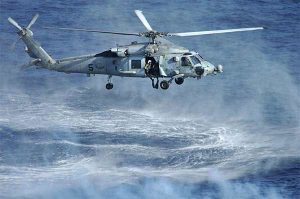
810G covers accelerated corrosion using salt fog in Method 509.5. This method comprises 10 pages. This is one of the more commonly performed tests and is definitely required for items sold to the Navy or for use in coastal areas. Salt is one of the most pervasive chemical compounds in the world. It is found in the oceans and seas, the atmosphere, ground surfaces, and lakes and rivers. It is impossible to avoid exposure to salt.
The purpose of Method 509.5 is to assess the effectiveness of protective coatings and finishes on materials. All unprotected metals will corrode if not protected with some finish such as plating or paint. Finishes can also have pinholes or cracks allowing salt to reach the underlying material, causing corrosion. The Method can also be applied to determine the effects of salt deposits on the physical and electrical aspects of the assembly.
The effects of a corrosive environment include:
- Corrosion effects such a electrochemical reaction, stress corrosion, and the formation of acidic/alkaline solutions
- Electrical effects such as impairment of electrical material due to salt deposits, production of conductive coatings causing short circuits, and corrosion of insulating materials.
- Physical effects such as clogging or binding of moving parts and blistering of paint as a result of underlying electrolysis.
Use Method 509.5 for screening purposes only to evaluate the effectiveness and quality of protective coatings and finishes. Either coupons (samples) or the final assembly can be evaluated. The Method is not representative of the natural environment but is a good indicator of potential problem areas. In general, only apply this Method to material that will experience significant exposure to high levels of salt in the atmosphere, such as ship board applications.
The Method lists six limitations as follows:
- There is no relationship between this test and any real world exposure duration.
- It has not been demonstrated that a direct relationship exists between salt fog corrosion and corrosion due to other media.
- This test has does not imply the material will survive under all corrosive conditions.
- This test is unreliable for predicting the service life of materials in corrosive conditions.
- Effects of humidity and fungus growth are not represented in this test.
- This test is not intended to be used for sample or coupon testing in lieu of assemblage testing.
The Method requires a 5% (+/-1%) salt fog be produced and circulated (with minimal air velocity) around the item under test. Condensation should not be allowed to drip onto the test items. This is a fog test, not a salt water exposure test. The test is recommended to last 48 hours with a 48 hour drying time although an alternating 24 hour test cycle (24 fog, 24 drying, 24 fog, 24 drying) has proven to be more destructive. The test temperature is specified as 35 deg C which has been historically accepted and is not necessarily indicative of the actual environment. Alternate temperatures can be used as appropriate.
In general, test samples from the salt fog test should not be used in other tests. If only one sample is available or a sample must be reused for other tests, in terms of a schedule, humidity and fungus growth testing should be performed before the salt fog test and sand and dust testing after the salt fog test.
After the test, the item should be inspected for physical, electrical and corrosion effects. There can be surprising results. We tested a sample rear panel with a nickel finish compared to a zinc plated finish. As it turned out, the more expensive nickel had apparent pinholes in the finish and failed miserably while the much less expensive zinc coating showed only a light surface corrosion with no damage to the underlying metal.
CP Technologies has worked with various customers to define test procedures, as required by MIL-STD-810G, to validate our rugged rackmount computer systems and displays.
